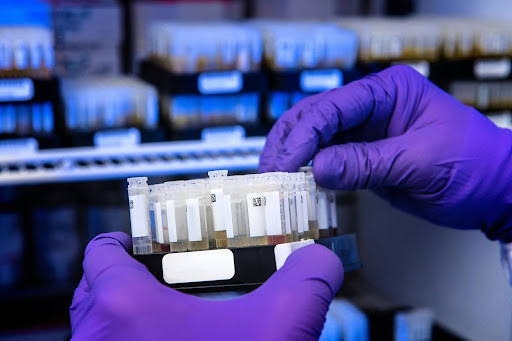
Peptides have emerged as promising agents in dermatology research, offering potential support to the function of the skin barrier. Studies suggest that these bioactive compounds, consisting of short chains of amino acids, may interact with skin cells to influence various physiological processes. As the understanding of peptides' mechanisms expands, their implication in developmental research becomes increasingly sophisticated.
Peptides: Structural and Functional Overview
Peptides are composed of two or more amino acids linked by peptide bonds. Research indicates that they may play diverse roles within an organism, ranging from signaling molecules to structural components. In dermatology research, peptides are speculated to interact with skin cells to promote various physiological responses.
One type of peptide, signal peptides, may influence cellular communication. These peptides are believed to bind to receptors on the cell surface, initiating a cascade of events that can lead to cellular proliferation, migration, or differentiation. Another category, carrier peptides, might facilitate the delivery of essential trace elements required for enzymatic activities. For instance, copper peptides are hypothesized to support skin elasticity by promoting collagen synthesis.
Peptides: Mechanisms of Action
The mechanisms through which peptides may exert their impacts are not fully understood, but several theories have been proposed. One hypothesis suggests that signal peptides may stimulate collagen production by activating specific cellular pathways. Collagen, a critical protein in the skin's extracellular matrix, provides structural support and elasticity. By promoting collagen synthesis, peptides might help reduce the depth and length of wrinkles along the surface of the skin barrier.
Additionally, some peptides are theorized to have antimicrobial properties. These antimicrobial peptides (AMPs) might disrupt the membranes of bacteria, thereby protecting the skin from infections. AMPs might be crucial in maintaining the skin's microbiome, a complex community of microorganisms contributing to skin function.
Peptides & Oxidative Stress
Investigations purport that another potential of peptides may be their antioxidant activity. Oxidative stress, resulting from an imbalance between reactive oxygen species (ROS) and antioxidants, may lead to cellular damage and cell aging. Certain peptides might scavenge ROS, reducing oxidative stress and its detrimental impacts on the skin. Findings imply that these peptides might help maintain the skin's integrity by mitigating oxidative damage.
Peptides & Wounds
Peptides are also thought to play a role in wound healing. The wound healing process involves a series of coordinated events, including inflammation, tissue formation, and remodeling. Research indicates that certain peptides may accelerate wound healing by promoting cell migration and proliferation, angiogenesis (creating new blood vessels), and extracellular matrix synthesis. For example, the peptide Thymosin beta-4 is theorized to support wound healing by stimulating keratinocyte and fibroblast migration, two cell types essential for skin repair.
Peptides & Cell Aging
The anti-aging potential of peptides is a significant area of interest. As the skin ages, it is believed to undergo structural and functional changes, such as reduced collagen production and increased formation of matrix metalloproteinases (MMPs), which degrade collagen. Studies postulate that some peptides may inhibit MMP activity, preserving collagen and maintaining skin firmness. Additionally, scientists speculate that peptides that stimulate collagen synthesis might counteract the age-related decline in collagen levels, potentially reducing the depth of wrinkles and improving skin texture.
Skin Barrier Function
The skin barrier, composed of the stratum corneum and lipid matrix, is essential for maintaining skin hydration and protecting against external aggressors. It has been hypothesized that peptides might support skin barrier function by promoting the synthesis of barrier lipids and proteins. For example, ceramide-containing peptides are thought to boost the production of ceramides, lipids that play a critical role in skin barrier integrity. Improved barrier function can lead to better hydration and protection against irritants.
Some peptides are theorized to interfere with the melanin synthesis pathway, thereby reducing hyperpigmentation. For instance, peptide complexes that inhibit tyrosinase, the enzyme responsible for melanin production, have been speculated to effectively lighten dark spots and support a homeostatic appearance.
Growth Factors
Growth factors are proteins that regulate cell growth, proliferation, and differentiation. Peptides appear to interact with growth factors to modulate their activity. For example, peptides that mimic growth factor binding sites are believed to support the activity of endogenous growth factors.
Peptides: Future Research Directions
The field of peptides is continually evolving, with ongoing research aimed at elucidating their mechanisms and optimizing their formulations. Biotechnology and molecular biology advances will likely contribute to developing novel peptides with supported properties and targeted actions.
In conclusion, peptides hold significant promise in dermatology studies due to their diverse potential properties, including promoting collagen synthesis, enhancing wound healing, providing antioxidant protection, improving skin barrier function, and addressing hyperpigmentation.
Scientists interested in purchasing high-quality, affordable peptides for sale are encouraged to visit the Core Peptides website.
References
[i] Pai VV, Bhandari P, Shukla P. Peptides as cosmeceuticals. Indian J Dermatol Venereol Leprol. 2017 Jan-Feb;83(1):9-18. doi: 10.4103/0378-6323.186500. PMID: 27451932.
[ii] Gorouhi F, Maibach HI. Role of peptides in preventing or treating aged skin. Int J Cosmet Sci. 2009 Oct;31(5):327-45. doi: 10.1111/j.1468-2494.2009.00490.x. Epub 2009 Jun 30. PMID: 19570099.
[iii] Skibska A, Perlikowska R. Signal Peptides - Promising Ingredients in Cosmetics. Curr Protein Pept Sci. 2021;22(10):716-728. doi: 10.2174/1389203722666210812121129. PMID: 34382523.
[iv] Thapa RK, Winther-Larsen HC, Diep DB, Tønnesen HH. Preformulation studies on novel garvicin KS peptides for topical implications. Eur J Pharm Sci. 2020 Aug 1;151:105333. doi: 10.1016/j.ejps.2020.105333. Epub 2020 Apr 5. PMID: 32268197.
[v] Thapa RK, Winther-Larsen HC, Diep DB, Tønnesen HH. Photostability studies of GarKS peptides for topical formulation development. Eur J Pharm Sci. 2021 Mar 1;158:105652. doi: 10.1016/j.ejps.2020.105652. Epub 2020 Nov 26. PMID: 33248238.







